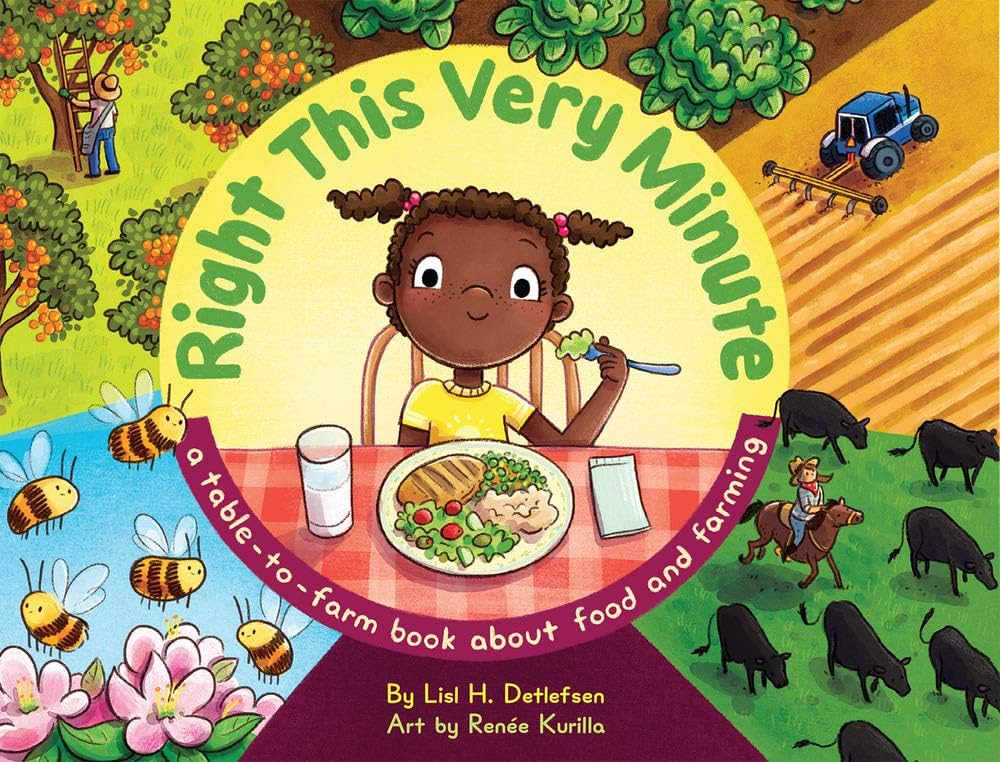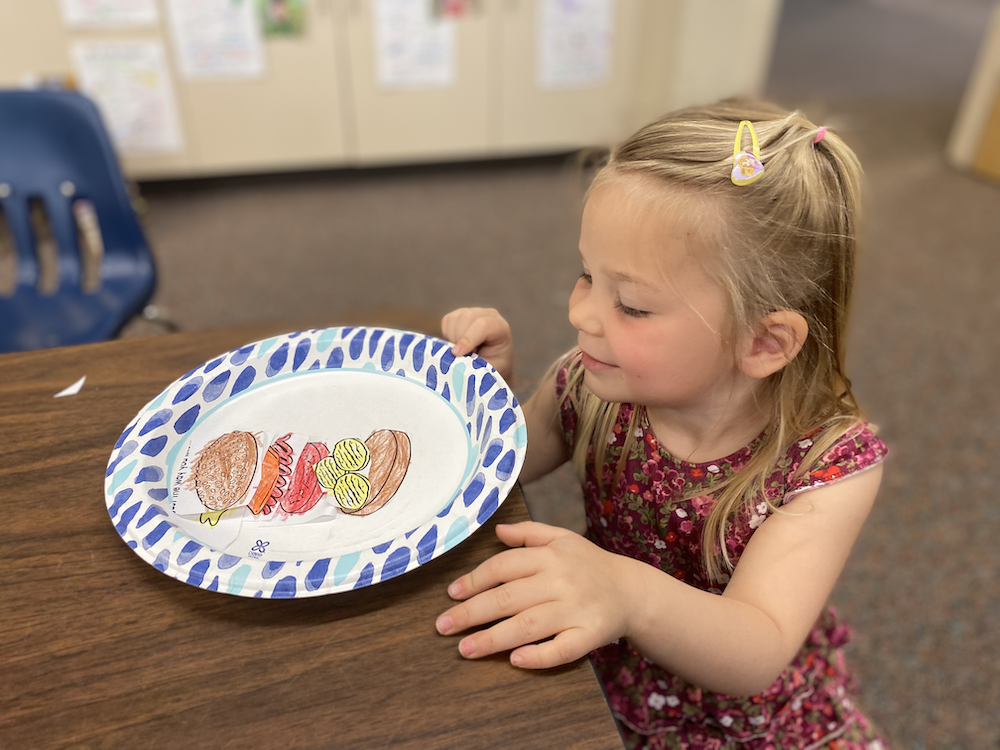Agricultural Literacy Curriculum Matrix
Lesson Plan
All Kinds of Farms
Grade Level
Purpose
Students discover that there are many different types of farms. Grades PreK-K
Estimated Time
Materials Needed
Engage:
- Blank piece of paper (1 per student)
- Crayons
Circle Time: All Kinds of Farms
- Right This Very Minute by Lisl H. Detlefsen
- Vocabulary Development Photo Cards (Prior to the lesson, cut and laminate for future use)
- On the Farm song
Literacy: Crop Letter Match
- Sensory bin filled with rice, alphabet magnets or foam letters, and Crop Cards (Prior to the lesson, cut and laminate for future use)
- Crop Letter Match activity sheet, attached to clipboard (1 per student)
- Crayons
Math: Counting Crops Interactive Reader
- Counting Crops interactive reader
- Counters
- Crayons or markers
Social Studies: Where Does My Burger Come From?
- Burger Ingredients (Prior to the lesson, cut and laminate for future use)
- Pocket chart
- Scissors
- Crayons or markers
- Build-a-Burger handout
- Glue sticks
- Paper plates
Vocabulary
aquaculture: the cultivation of aquatic organisms (such as fish or shellfish) especially for food
commodity: a primary agricultural product that can be bought and sold
crop: a cultivated plant that is grown and harvested, especially a grain, fruit, or vegetable
dairy: all milk products, including milk, yogurt, cheese etc
grain: the edible seed or seed-like fruit of grasses that are cereals (such as wheat, corn, and rice)
livestock: farm animals (such as cows, horses, and pigs) that are kept, raised, and used by people
orchard: a place where fruit or tree nuts are grown
poultry: domestic fowl, such as chickens, turkeys, ducks, and geese
Background Agricultural Connections
In an effort to simplify the idea of where food comes from, many early learners are implicitly taught that most farms look like the farms of the past: a single family living and working on a farm to provide for their day-to-day needs. In the past, the entire family would work on the farm and there was always work to be done. Typically, these farms would grow many different fruits and vegetables, with a big barn that housed a variety of livestock animals: a small brood of chickens, a horse, several cows and pigs, and a small herd of sheep. The family's food came from their own farm. Although some farms are still like that, today we get most of our food from much larger farms—still family owned—that specialize in growing one type of food. There are egg farms, dairy farms, almond farms, and apple farms. Modern farms require specialized knowledge, skills, and machinery in order to survive the global marketplace.
This lesson is part of a series called, Life on the Farm. The remaining lessons can be found at the following links:
- All Kinds of Farms
- Animals on the Farm
- Crops on the Farm
- Machines on the Farm
- Thank You Farmers
There are many different types of farms, each specializing in producing specific commodities. Farms can be diverse in size and product. They play an important role in providing the food and fiber we use every day.
Crop Farms
These farms grow various crops, such as grains, fruits, vegetables, and nuts.
Livestock Farms
Livestock farms raise animals for various purposes, including meat, milk, wool, and other products. Examples include cattle ranches, poultry farms, and sheep farms.
Dairy Farms
These farms specifically produce milk and other dairy products, often using dairy cows.
Poultry Farms
Poultry farms raise chickens, ducks, turkeys, and other birds primarily for meat and egg production.
Aquaculture Farms
Also known as fish farms, these facilities cultivate fish, shellfish, and other aquatic organisms in controlled environments.
Orchards
Orchards grow fruit-bearing and nut-bearing trees.
Engage
- Provide each student with a blank piece of paper and ask them to draw a farm.
- Compare the drawings. How are they similar or different? Address any misconceptions or stereotypes.
- Clarify that not all farms are the same.
- Explain to the students that they will be examining different types of farms.
Explore and Explain
Circle Time: All Kinds of Farms
 Read the book, Right This Very Minute by Lisl H. Detlefsen.
Read the book, Right This Very Minute by Lisl H. Detlefsen.- After reading, review the Vocabulary Development Photo Cards.
- Show the cards to the children and say the name of each photo on the card. Encourage the children to repeat the vocabulary words after you.
- Ask the children to identify the object or action on the card and describe what it is or does.
- Possible prompts:
- Grain: Some farms grow grains. Grain is a tiny piece of food that grows on plants like wheat, rice, and corn. We use grains to make yummy things like bread, cereal, and pasta. What grains do you like to eat?
- Fruit: Some farms grow fruit. Fruit is a food that grows on trees or plants. Some examples of fruit are apples, bananas, cherries, strawberries, and grapes. What are some of your favorite fruits?
- Vegetables: Some farms grow vegetables. Vegetables are healthy foods that come from plants. Some vegetables grow above ground, like lettuce, tomatoes, and cucumbers, while others grow underground, like carrots, potatoes, and onions. Can you think of any vegetables that are green? Red? Purple?
- Harvest: Harvest is when farmers pick the food they grew in their fields. Fruits and vegetables like blueberries, peaches, tomatoes, cucumbers, and corn are all harvested in the summer. Fruits and vegetables like apples, pumpkins, and carrots are harvested in the fall when they're ripe and ready to eat. Have you ever harvested your own fruits or vegetables?
- Livestock: Livestock are animals that are raised on farms for food or other useful things. Some examples of livestock are cows, pigs, sheep, goats, and chickens. Can you think of some food we get from livestock?
- Weather: Weather is what we call the different kinds of conditions outside, like sunny, rainy, cloudy, or snowy. For farmers, the weather is very important because it helps their plants grow. Why do farmers like sunny weather? Why do farmers like rainy weather?
- Teach the students the On the Farm song. Here are some tips for teaching preschoolers a new song:
- Use Visuals: Use pictures or props to help children understand the lyrics and the tune of the song. You can use hand gestures or actions to make the song more engaging.
- Break it Down: Teach the song in small parts, repeating each part until the children are familiar with it. Sing the song slowly and clearly so the children can follow along.
- Repeat, Repeat, Repeat: Encourage the students to sing the song repeatedly until they have memorized the lyrics and the tune. Repetition is key in helping children learn and remember new songs.
Literacy: Crop Letter Match
 Explain to the students that farmers and ranchers grow or raise many different commodities. Some commodities come from animals, like milk, wool, and meat. Some commodities are crops, like grains, fruits, and vegetables.
Explain to the students that farmers and ranchers grow or raise many different commodities. Some commodities come from animals, like milk, wool, and meat. Some commodities are crops, like grains, fruits, and vegetables.- Tell the students that they will look through the sensory bin to find matching crops and letters.
- Show the students how to match the letters to the Crop Cards. For example, find the letter "A" and search for a crop that also starts with the letter "A" to make a match. Locate the "almond" crop card.
- Instruct the students to color the corresponding letter on the Crop Letter Match activity sheet when they find a match.
Math: Counting Crops Interactive Reader
- Review or introduce what a ten frame is and what it's used for. For example, "A ten frame is a tool that helps us count and understand numbers better."
- Show the students a physical ten frame or a picture of one. Explain that a ten frame has two rows with five spaces in each row, making ten total spaces.
- Have the students practice counting with a ten frame. Give the students a number and invite them to place the same number of counters on the ten frame. Then, count together to reinforce the concept.
- Distribute the Counting Crops interactive reader and invite the students to complete the booklet. The students may use counters to complete the ten frames, or draw a picture of each crop in the corresponding number of spaces.
Social Studies: Where Does My Burger Come From?
 Ask the students, "Have you ever taken a bite of a hamburger and wondered where all the ingredients came from?" Explain that in this activity, students will take a closer look at the ingredients on a burger and identify which ingredients are grown by farmers and ranchers in the community.
Ask the students, "Have you ever taken a bite of a hamburger and wondered where all the ingredients came from?" Explain that in this activity, students will take a closer look at the ingredients on a burger and identify which ingredients are grown by farmers and ranchers in the community.- Invite the students to brainstorm different ingredients used to make a burger. With each idea, place the corresponding ingredient on the pocket chart. Talk about where the ingredient comes from. For example, "I love pickles on my burger. Give a thumbs up if you like pickles too. What vegetables do we use to make pickles? (Cucumbers) Who grows cucumbers? (Farmers) Cucumbers are vegetables that are usually grown in a field."
- Continue with each burger ingredient, making connections to local agriculture when possible.
- Bun: wheat
- Patty: meat, usually beef
- Ketchup: tomatoes
- Mustard: mustard plant
- Mayonnaise: oil (canola or soybean) and eggs
- Cheese: milk, usually from cows
- Pickles: cucumbers
- Tomatoes
- Lettuce
- Distribute the Build-a-Burger handout. Invite the students to color the different ingredients, then cut them out and glue them onto a paper plate. If they start with a bottom ingredient first (most likely the bottom of the bun), the other ingredients will fit properly on top.
Elaborate
- Take a field trip to a farm, either in person or virtually.
Evaluate
After conducting these activities, review and summarize the following key concepts:
- There are many different types of farms.
- Some farms grow crops and some farms raise livestock.
- The weather is important to farmers.
Acknowledgements
Engage section adapted from the lesson Many Types of Farms developed by New York Agriculture in the Classroom.
Recommended Companion Resources
Author
Organization
| We welcome your feedback! If you have a question about this lesson or would like to report a broken link, please send us an email at matrixelearning@gmail.com. If you have used this lesson and are willing to share your experience, we will provide you with a coupon code for 10% off your next purchase at AgClassroomStore. |
